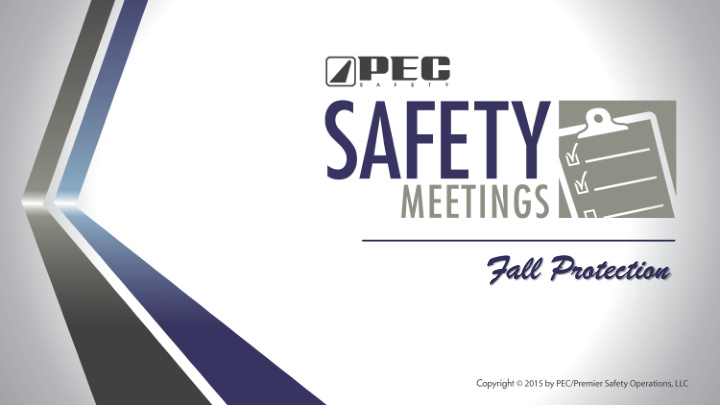



Fall Protection
Falling is no joke. . . . . . According to the Bureau of Labor Statistics , roughly 570 fatal work injuries that occurred in 2012 resulted from workers falling to a lower level. 45% of injuries involved falls of 20 ft or less PPT-SM-FP 2015 2
Guy’s week is about to fall out of control. Hopefully, he will learn from his mistakes and come to understand that wearing fall protection equipment while working at heights could save your life . PPT-SM-FP 2015 3
Guy is working on the side of an oil derrick . He decides to take off his full body harness to eat a sandwich when… PPT-SM-FP 2015 4
*SLIP* …he loses his balance and falls to the ground. PPT-SM-FP 2015 5
Never work at heights unless trained to do so. Workers should be aware of fall hazards and wear fall protection when required. Guy should have never removed his full body harness while he was still at a height above 4 ft from the lower level. PPT-SM-FP 2015 6
Full body harnesses are made up of straps that distribute the force of a fall, making the wearer less likely to sustain internal injuries. Body harness straps must be tight , but not enough to restrict motion. Beware of genital entrapment ! PPT-SM-FP 2015 7
The attachment point of a full body harness must be located in the center of the back and near shoulder level. Refer to the manufacturer’s instructions when in doubt. PPT-SM-FP 2015 8
Guy , what should you always do when working at heights ? PPT-SM-FP 2015 9
Tie-off Point Fall Brake Workers must wear personal fall arrest systems when working at heights. Lanyard Full Body Harness PPT-SM-FP 2015 10
The type of system used should be appropriate for your work environment. Review a copy of your company’s fall protection plan and always report broken or missing guardrails. PPT-SM-FP 2015 11
Personal fall arrest systems must be rigged so that workers cannot fall 6 ft and contact a lower level. Fall protection equipment must be worn at a height of: 4 ft or above in general industry 6 ft or above in construction industry PPT-SM-FP 2015 12
Guy is doing some repairs to the side of a dam. In a rush to start the job, he doesn’t inspect his fall protection equipment when… PPT-SM-FP 2015 13
*SNAP* A partially torn and weakened lanyard sends Guy falling to the ground. PPT-SM-FP 2015 14
Guy , what are we supposed to do before wearing fall protection? PPT-SM-FP 2015 15
That’s right, Guy ! All parts of a fall arrest system must be inspected prior to each use and on a routine basis – preferably monthly . Inspect fall arrest systems for: Mildew Holes Chemical damage Wear Cuts Damaged or corroded hardware Tears UV damage PPT-SM-FP 2015 16
Damaged, modified, or defective equipment must be removed from service, and repaired or destroyed . Corroded Carabiner Worn Harness Rusted Buckle Degraded Sling PPT-SM-FP 2015 17
Lanyards connect the anchor to the harness. They are attached to the back of full body harnesses and must be : Interconnected using double 1. locking hooks. Connected to a properly designed D-ring . 2. Do not shorten lanyards by tying knots in them or modify them with spare cable or rope. PPT-SM-FP 2015 18
Many companies require the use of double lanyards so that workers are anchored at all times. This is referred to as “ 100% tie-off .” PPT-SM-FP 2015 19
Guy is doing a little painting work on the side of a building . Assuming he already had a good grip, he decides to use a weak scaffold guardrail as a tie-off point, when… PPT-SM-FP 2015 20
*WOOPSIE* The guardrail breaks and Guy falls to the ground. It is estimated that 80% of all fall protection equipment errors are because of a poor choice for a tie-off point or anchorage. PPT-SM-FP 2015 21
Tie-off points – or anchor points – should be located as above and behind you as possible. Avoid tie-offs where a line passes over or around rough or sharp surfaces. This can reduce strength drastically. Avoid using process piping, hand railings, or cable trays as tie-off points unless authorized . PPT-SM-FP 2015 22
Wear fall protection if on a working platform or if immediate danger is below. PPT-SM-FP 2015 23
Occasionally, it is necessary for workers to be lifted and lowered by air hoist or hydraulic winch . Riders must wear a full body harness that meets regulations , except in the case of personnel baskets . Let’s see if Guy can manage to break a fall on his last assignment of the day. PPT-SM-FP 2015 24
Guy and a coworker are installing metal sheets on a building when... PPT-SM-FP 2015 25
*DING* Guy , being aware, realizes his coworker is not latched to a fall brake . He retrieves the necessary equipment . PPT-SM-FP 2015 26
Good Thinking, Guy ! PPT-SM-FP 2015 27
Fall brakes control deceleration during a fall. Two types include: Webbing tear-aways Retractable inertial PPT-SM-FP 2015 28
Fall arrest equipment subjected to the force of a fall must be : Removed from service Repaired Inspected OR Destroyed The method of action you take will depend on the equipment type. PPT-SM-FP 2015 29
Doing this will help you and your coworkers get back to what matters most. Stay safe! PPT-SM-FP 2015 30
PPT-SM-FP 2015 31
Recommend
More recommend